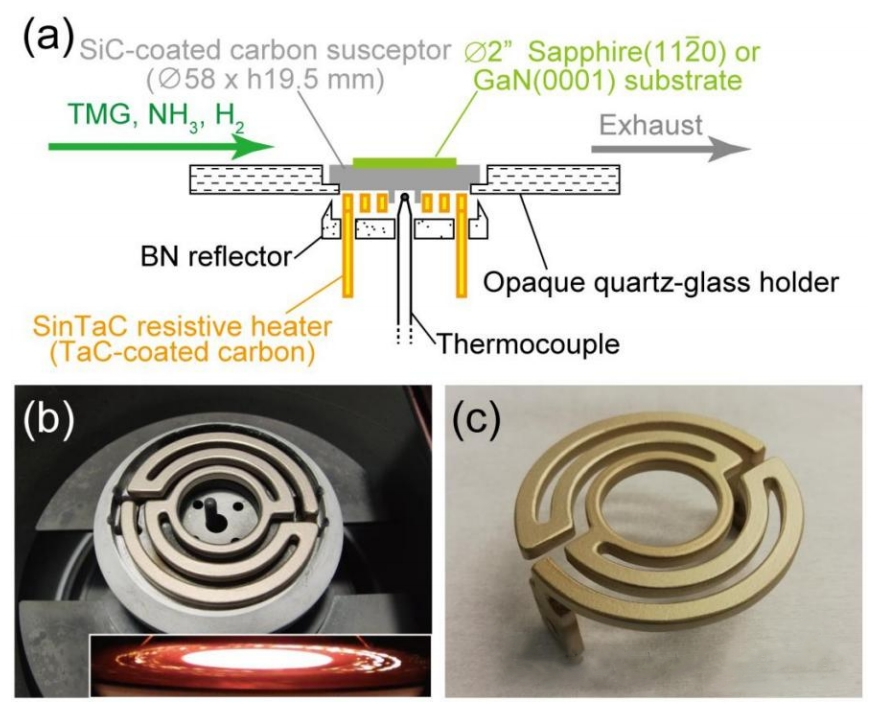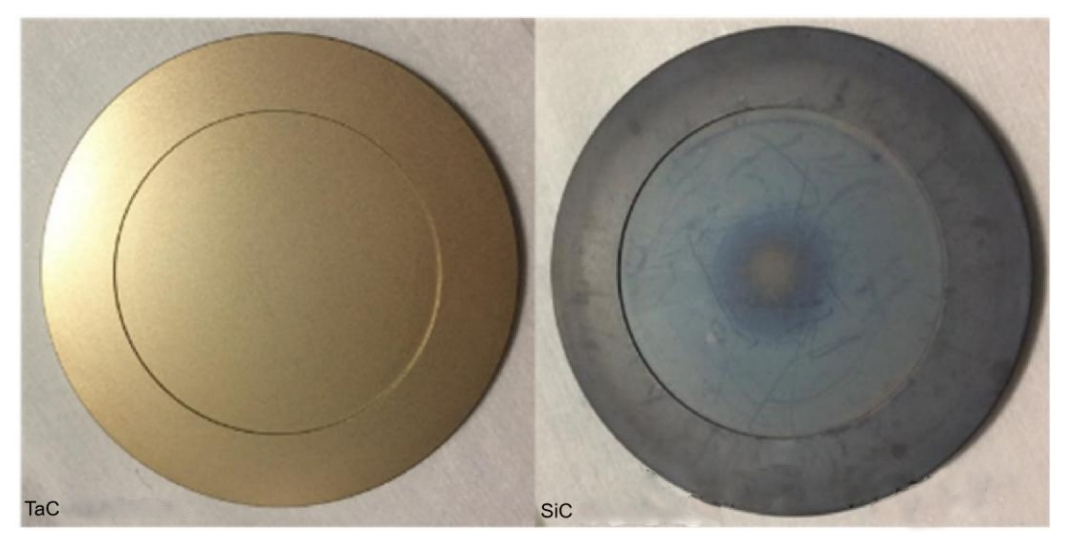
- English
- Español
- Português
- русский
- Français
- 日本語
- Deutsch
- tiếng Việt
- Italiano
- Nederlands
- ภาษาไทย
- Polski
- 한국어
- Svenska
- magyar
- Malay
- বাংলা ভাষার
- Dansk
- Suomi
- हिन्दी
- Pilipino
- Türkçe
- Gaeilge
- العربية
- Indonesia
- Norsk
- تمل
- český
- ελληνικά
- український
- Javanese
- فارسی
- தமிழ்
- తెలుగు
- नेपाली
- Burmese
- български
- ລາວ
- Latine
- Қазақша
- Euskal
- Azərbaycan
- Slovenský jazyk
- Македонски
- Lietuvos
- Eesti Keel
- Română
- Slovenski
- मराठी
- Srpski језик
Application and Development Challenges of TaC Coated Graphite Components
2024-05-23
In the context of Silicon Carbide (SiC) wafer growth, traditional graphite materials and carbon-carbon composites used in the thermal field face significant challenges in withstanding the complex atmosphere at 2300°C (Si, SiC₂, Si₂C). These materials not only have a short lifespan, requiring replacement of different parts after one to ten furnace cycles, but also experience sublimation and volatilization at high temperatures. This can lead to the formation of carbon inclusions and other crystal defects. To ensure the high quality and stable growth of semiconductor crystals while considering industrial production costs, it is essential to prepare ultra-high temperature and corrosion-resistant ceramic coatings on graphite components. These coatings extend the lifespan of graphite parts, inhibit impurity migration, and enhance crystal purity. During SiC epitaxial growth, SiC-coated graphite bases are typically used to support and heat single crystal substrates. However, the lifespan of these bases still needs improvement, and they require periodic cleaning to remove SiC deposits from the interfaces. In comparison, Tantalum Carbide (TaC) coatings offer superior resistance to corrosive atmospheres and high temperatures, making them a crucial technology for achieving optimal SiC crystal growth.
With a melting point of 3880°C, TaC exhibits high mechanical strength, hardness, and thermal shock resistance. It maintains excellent chemical inertness and thermal stability under high-temperature conditions involving ammonia, hydrogen, and silicon-containing vapors. Graphite (carbon-carbon composite) materials coated with TaC are highly promising as replacements for traditional high-purity graphite, pBN-coated, and SiC-coated components. Additionally, in the aerospace field, TaC has significant potential for use as a high-temperature oxidation-resistant and ablation-resistant coating, offering broad application prospects. However, achieving a dense, uniform, and non-peeling TaC coating on graphite surfaces and promoting its industrial-scale production present several challenges. Understanding the coating’s protective mechanisms, innovating production processes, and competing with top international standards are crucial for the growth and epitaxial development of third-generation semiconductors.
In conclusion, the development and application of TaC coated graphite components are critical for advancing SiC wafer growth technology. Addressing the challenges in TaC coating preparation and industrialization will be key to ensuring high-quality semiconductor crystal growth and expanding the use of TaC coatings in various high-temperature applications.
1. Application of TaC Coated Graphite Components
(1) The crucible, seed crystal holder and flow tube in PVT Growth of SiC and AlN Single Crystals
During the physical vapor transport (PVT) method for SiC preparation, the seed crystal is placed in a relatively low-temperature zone while the SiC raw material is in a high-temperature zone (above 2400°C). The raw material decomposes to produce gaseous species (SiXCy), which are transported from the high-temperature zone to the low-temperature zone where the seed crystal is located. This process, which includes nucleation and growth to form single crystals, requires heat field materials like crucibles, flow rings, and seed crystal holders that are resistant to high temperatures and do not contaminate the SiC raw material and crystals. Similar requirements exist for AlN single crystal growth, where heating elements must resist Al vapor and N2 corrosion and have a high eutectic temperature to shorten the crystal preparation cycle.
Studies have shown that using TaC coated graphite materials in the heat field for SiC and AlN preparation results in cleaner crystals with fewer carbon, oxygen, and nitrogen impurities. The edge defects are minimized, and the resistivity across different regions is significantly reduced, along with the micropore and etch pit densities, greatly enhancing crystal quality. Furthermore, the TaC crucible shows negligible weight loss and no damage, allowing for reuse (with a lifespan of up to 200 hours), enhancing the sustainability and efficiency of single crystal preparation.
(2 ) The heater in MOCVD GaN Epitaxial Layer Growth
MOCVD GaN growth involves using chemical vapor deposition technology to grow thin films epitaxially. The precision and uniformity of the chamber temperature make the heater a crucial component. It must consistently and uniformly heat the substrate over long periods and maintain stability at high temperatures under corrosive gases.
To improve the performance and recyclability of the MOCVD GaN system heater, TaC coated graphite heaters have been successfully introduced. Compared to traditional heaters with pBN coatings, TaC heaters show comparable performance in crystal structure, thickness uniformity, intrinsic defects, impurity doping, and contamination levels. The low resistivity and surface emissivity of the TaC coating enhance the heater’s efficiency and uniformity, reducing energy consumption and heat dissipation. The adjustable porosity of the coating further improves the heater’s radiation characteristics and extends its lifespan, making TaC coated graphite heaters a superior choice for MOCVD GaN growth systems.

Figure 2. (a) Schematic diagram of the MOCVD apparatus for GaN epitaxial growth
(b) Formed TaC coated graphite heater installed in the MOCVD setup, excluding the base and supports (the inset shows the base and supports during heating)
(c) TaC coated graphite heater after 17 cycles of GaN epitaxial growth
(3) Epitaxial Coating Trays (Wafer Carriers)
Wafer carriers are critical structural components in the preparation and epitaxial growth of third-generation semiconductor wafers such as SiC, AlN, and GaN. Most wafer carriers are made of graphite and coated with SiC to resist corrosion from process gases, operating within a temperature range of 1100 to 1600°C. The anti-corrosion ability of the protective coating is crucial for the carrier’s lifespan.
Research indicates that TaC’s corrosion rate is significantly slower than SiC in high-temperature ammonia and hydrogen environments, making TaC coated trays more compatible with blue GaN MOCVD processes and preventing impurity introduction. LED performance grown using TaC carriers is comparable to traditional SiC carriers, with the TaC coated trays demonstrating superior lifespan.

Figure 3. Wafer trays used in the MOCVD equipment (Veeco P75) for GaN epitaxial growth. The tray on the left is coated with TaC, while the tray on the right is coated with SiC
2. Challenges in TaC Coated Graphite Components
Adhesion: The thermal expansion coefficient difference between TaC and carbon materials results in low coating adhesion strength, making it prone to cracking, porosity, and thermal stress, which can lead to coating spallation under corrosive atmospheres and repeated temperature cycling.
Purity: TaC coatings must maintain ultra-high purity to avoid introducing impurities at high temperatures. Standards for evaluating free carbon and intrinsic impurities within the coating need to be established.
Stability: Resistance to high temperatures above 2300°C and chemical atmospheres is critical. Defects such as pinholes, cracks, and single crystal grain boundaries are susceptible to corrosive gas infiltration, leading to coating failure.
Oxidation Resistance: TaC begins oxidizing at temperatures above 500°C, forming Ta2O5. The oxidation rate increases with temperature and oxygen concentration, starting from grain boundaries and small grains, leading to significant coating degradation and eventual spallation.
Uniformity and Roughness: Inconsistent coating distribution can cause localized thermal stress, increasing the risk of cracking and spallation. Surface roughness affects interactions with the external environment, with higher roughness leading to increased friction and uneven thermal fields.
Grain Size: Uniform grain size enhances coating stability, whereas smaller grains are prone to oxidation and corrosion, leading to increased porosity and reduced protection. Larger grains can cause thermal stress-induced spallation.
3. Conclusion and Outlook
TaC coated graphite components have significant market demand and broad application prospects. The mainstream production of TaC coatings currently relies on CVD TaC components, but the high cost and limited deposition efficiency of CVD equipment have not yet replaced traditional SiC coated graphite materials. Sintering methods can effectively reduce raw material costs and accommodate complex graphite shapes, meeting diverse application needs. Companies like AFTech, CGT Carbon GmbH, and Toyo Tanso have mature TaC coating processes and dominate the market.
In China, the development of TaC coated graphite components is still in its experimental and early industrialization stages. To advance the industry, optimizing current preparation methods, exploring new high-quality TaC coating processes, and understanding TaC coating protection mechanisms and failure modes are essential. Expanding TaC coating applications requires continuous innovation from research institutions and companies. As the domestic third-generation semiconductor market grows, the demand for high-performance coatings will increase, making domestic alternatives the future industry trend.**




